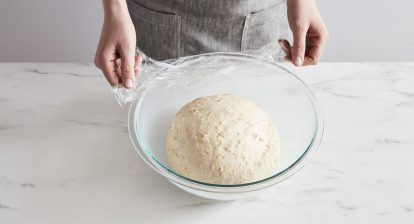Are you curious about freezing sourdough bread while preserving its delicious taste and delightful texture? Look no further! We are here to reveal the secrets of freezing this beloved bread. Sourdough bread is known for its tangy flavor and chewy consistency, making it a favorite among bread aficionados. But what if you have leftovers or want to save for later? Freezing sourdough bread can be a convenient solution, preserving its quality and allowing you to enjoy it as easily as possible. Stay tuned as we explore the best practices and tips for freezing this craft treasure.

Table of Contents
Can you freeze sourdough bread?
The short answer is yes, yyou can really freeze sourdough bread.
Read on to learn more about the many ways you can do this to extend the life of your bread dough.
Why freeze sourdough bread?
There are several reasons why freezing sourdough bread can be beneficial.
Here are some key benefits:
- Save: Freezing sourdough bread helps significantly extend its shelf life. Instead of worrying about your bread going stale or moldy in a few days, freezing allows you to store it for a long period of time without sacrificing its quality.
- Convenience: By freezing sourdough bread, you can have a ready supply of your favorite bread whenever you need it. It's especially helpful if you have limited access to fresh sourdough or want to stock up during busy periods.
- Waste minimization: If you find yourself with leftover sourdough bread that you won't use up in time, freezing it can prevent unnecessary waste. You can simply thaw it and enjoy it at a later date, reducing the chances of throwing away perfectly good bread.
- Enjoy at your own pace: Freezing lets you enjoy sourdough bread at your own pace. Whether you prefer to enjoy it slowly or have a slice whenever you feel like it, freezing offers the flexibility to indulge in this delicious bread whenever you want.
Does freezing affect sourdough bread?
Freezing can have some effects on sourdough bread, but with proper handling, its overall quality can be maintained quite well.
Some considerations to think about:
textures
Freezing can cause slight changes in the texture of sourdough bread. After thawing, the bread may become slightly denser or lose some of its initial chewiness. However, these changes are usually minimal and may not be noticeable to everyone.
The humidity
Freezing can cause some moisture loss in sourdough bread. To mitigate this, it is essential that the bread is stored properly to prevent excessive drying. Wrapping it tightly in plastic wrap or placing it in an airtight container before freezing helps retain moisture.
Taste
The taste of sourdough bread can be affected to a certain extent when raised. Some individuals report a slight decrease in the intensity of the bread's hardening after freezing.
However, this can change, and many people still find the flavor pleasant even after freezing.
Despite these potential effects, many sourdough enthusiasts find that freezing their bread is a worthwhile trade-off for the convenience and extended shelf life it provides. Proper packaging, quick freezing and careful thawing can help minimize any negative impacts and ensure that frozen sourdough bread remains a delicious treat.

How long can you freeze sourdough bread?
Sourdough bread can be frozen for a relatively long period if stored properly. When refrigerated at 0°F (-18°C) or below, sourdough bread can retain its quality for up to three months.
However, it is important to note that the bread is best enjoyed within the first month of freezing, as its quality and taste can gradually deteriorate over time.
To maximize the shelf life of frozen sourdough bread, it is essential to follow a few guidelines:
- PACKING: Wrap bread tightly in plastic wrap or aluminum foil to protect it from freezer burn and minimize moisture loss. Alternatively, you can place it in an airtight freezer-safe container or resealable bag.
- Setting the freezer: Store wrapped or packaged bread in the coldest part of your freezer to maintain its quality.
- melted: When you're ready to enjoy the frozen sourdough bread, let it thaw at room temperature, still wrapped, to prevent moisture loss. Avoid using a microwave or oven for defrosting, as they can cause uneven heating and affect the texture of the bread.
Remember that freezing times and results may vary depending on the specific characteristics of your sourdough bread and freezer. It is always recommended to evaluate the quality of the bread after thawing to ensure that it meets your expectations.
How to freeze sourdough bread?
To properly freeze sourdough bread and preserve its quality, follow these steps:
- Cool the bread: Allow the sourdough bread to cool completely after baking. Freezing warm bread can lead to excess moisture and possible freezer burn.
- Wrap the bread: Wrap the sourdough bread tightly in plastic wrap or aluminum foil. Make sure all the bread is covered to protect it from freezer burn and moisture loss. Alternatively, you can place it in a resealable freezer bag or an airtight freezer-safe container.
- Label and date: It is a good practice to label wrapped bread with the freeze date. That way, you can keep track of its shelf life and prioritize eating older bread.
- Put it in the fridge: Place the sourdough-wrapped bread in the coldest part of your freezer, ideally in a single layer to allow for even freezing. Avoid crowding or squeezing the bread to prevent warping.
- FROZEN: Allow the bread to freeze completely, which usually takes several hours. Once it's frozen, you can rearrange it as needed in the fridge to maximize space.
How to freeze sliced bread?
Freezing sliced bread is a convenient way to have individual portions ready for quick consumption.
Here's a simple guide to freezing sliced bread:
- Slice the bread: Start by slicing the sourdough bread to the desired thickness. It is recommended that you slice the bread as you would for regular consumption, such as sandwich-sized slices or smaller slices for baking.
- Prepare for freezing: Place the slices in a single layer on a baking sheet or flat surface lined with parchment paper. Make sure the slices don't touch each other, allowing for easy separation later.
- Pre-freeze (optional): For better storage and to prevent the slices from sticking, you can pre-freeze the individual slices for about 1 to 2 hours. This will firm them up a bit before packing.
- PACKING: Once the slices are pre-frozen (or if you choose to skip the pre-freeze step), transfer them to a freezer-safe bag or an airtight container. Remove any excess air from the bag or container to minimize the risk of frostbite. You can separate the slices with parchment paper or place them in individual sandwich bags for easier sharing.
- Label and date: Remember to label the bag or container with the freeze date to keep track of storage time.
- Freezing: Place the bag or container in the coldest part of your freezer and freeze until firm.
How to thaw and cool sourdough bread?
Proper thawing and cooling of sourdough bread is essential to restore its texture and flavor.
Here is a step-by-step guide:
- Remove from the freezer: Take the frozen bread out of the freezer and leave it wrapped while thawing to prevent moisture loss.
- Thaw at room temperature: Place the wrapped bread on a counter or cutting board at room temperature. Let it melt completely. Depending on the size of the bread or slices, defrosting may take several hours.
- Break it down and evaluate: Once thawed, remove the wrapper or packaging from the bread. Inspect the bread or slices to make sure there are no signs of frost burn or excess moisture.
- Refresh the crust (optional): If you want a crisper crust, you can chill the bread by preheating your oven to about 350°F (175°C). Lightly spray the bread with water or brush with a little water to moisten the crust. Place the bread in the oven for a few minutes until the crust becomes crispy. Be careful not to overheat or dry out the bread.
- Enjoy or reheat (optional): Sourdough bread is delicious when enjoyed as is, especially when it has a chewy texture and tangy flavor. However, if you prefer warm bread, you can warm it gently in a toaster, toaster or conventional oven for a few minutes. Avoid overheating to prevent over-drying.
Frozen Sourdough
Freezing sourdough bread can be a convenient solution to extend its shelf life and reduce waste. By following proper freezing, thawing, and chilling techniques, you can enjoy the delicious, chewy beauty of sourdough bread even after it's frozen.
So go ahead and reserve this darling bread without hesitation!
Did you know you can feed your sourdough starter? Check out my blog post how to raise sourdough starter to find out how!
Frequently asked questions
How long does sourdough bread last in the fridge?
Sourdough bread stored in the refrigerator can usually last about 5-7 days. The cool temperature helps to slow down the freezing process. To maintain freshness, it is best to keep the bread in an airtight bag or container to prevent it from drying out.
Can you rise sourdough bread dough?
Yes, you can rise bread dough with sourdough. After forming the dough, let it go through the initial rise. Then, wrap tightly in plastic wrap or place in an airtight container before freezing. When ready to bake, thaw the dough in the refrigerator overnight and proceed with the final rising and baking process to obtain a delicious sourdough patty.







